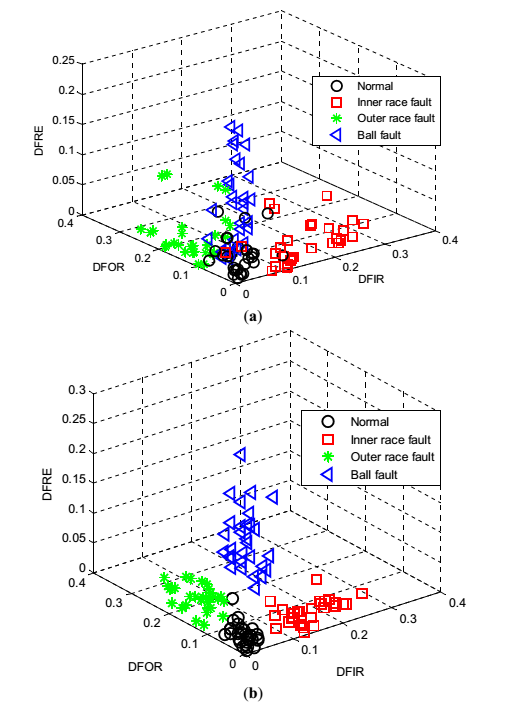
Detect Defect for Wheel-Bearings with Time-Spectral Kurtosis and Entropy
Apr 29, 2014 Email"> PrintText Size

Wheel-bearings are an essential mechanical component of railway vehicles. However, they easily acquire defects due to their high-speed operating conditions and constant metal-metal contact. It can affect the normal operation of railway traffic systems, and ultimately lead to train derailments. Therefore, the detection of bearing defects is of great importance, especially with the great improvements of train speed in recent years. The conventional spectral kurtosis (SK) technique provides an optimal bandwidth for envelope demodulation. However, this technique may cause false detections when processing real vibration signals for wheel-bearings, because of sparse interference impulses.
Researchers from the Beijing University of Posts and Telecommunications and Institute of Acoustics, Chinese Academy of Sciences worked together to have investigated a novel defect detection method, based on an in-depth study of the SK abnormity for real wheel-bearings. The novel defect detection method utilizes entropy, time-spectral kurtosis (TSK) and support vector machine (SVM).
In this method, the possible outliers in the short time Fourier transform (STFT) amplitude series are first estimated and preprocessed with information entropy. Through entropy, it can effectively estimate and preprocess outliers in STFTAS, and reduce the influence of interference impulses on characteristic frequency extraction greatly. And then, the method extends the SK technique to the time-domain, and extracts defective frequencies from reconstructed vibration signals by TSK filtering. Finally, the multi-class SVM was applied to classify bearing defects. The effectiveness of the proposed method is illustrated using real wheel-bearing vibration signals.
Experimental results show that the method provides a higher accuracy for the defective frequency detection, and classifies four conditions of roller bearings more accurately than the conventional SK-based envelope demodulation (see Fig. 1). In addition, the proposed method has better generalization and robustness for interference impulses in railway applications.

Fig. 1 The distribution of defective features. (a) SK-based envelope demodulation; (b)TSK filtering (Image by CHEN).
This research is supported by the National Natural Science Foundation of China (Grant No. 11304019).
Journal References:
CHEN Bin, YAN Zhaoli and CHEN Wei. Defect Detection for Wheel-Bearings with Time-Spectral Kurtosis and Entropy. Entropy (vol. 16, no.1, pp. 607-626, JAN 2014). DOI: 10.3390/e16010607
Wheel-bearings are an essential mechanical component of railway vehicles. However, they easily acquire defects due to their high-speed operating conditions and constant metal-metal contact. It can affect the normal operation of railway traffic systems, and ultimately lead to train derailments. Therefore, the detection of bearing defects is of great importance, especially with the great improvements of train speed in recent years. The conventional spectral kurtosis (SK) technique provides an optimal bandwidth for envelope demodulation. However, this technique may cause false detections when processing real vibration signals for wheel-bearings, because of sparse interference impulses.
Researchers from the Beijing University of Posts and Telecommunications and Institute of Acoustics, Chinese Academy of Sciences worked together to have investigated a novel defect detection method, based on an in-depth study of the SK abnormity for real wheel-bearings. The novel defect detection method utilizes entropy, time-spectral kurtosis (TSK) and support vector machine (SVM).
In this method, the possible outliers in the short time Fourier transform (STFT) amplitude series are first estimated and preprocessed with information entropy. Through entropy, it can effectively estimate and preprocess outliers in STFTAS, and reduce the influence of interference impulses on characteristic frequency extraction greatly. And then, the method extends the SK technique to the time-domain, and extracts defective frequencies from reconstructed vibration signals by TSK filtering. Finally, the multi-class SVM was applied to classify bearing defects. The effectiveness of the proposed method is illustrated using real wheel-bearing vibration signals.
Experimental results show that the method provides a higher accuracy for the defective frequency detection, and classifies four conditions of roller bearings more accurately than the conventional SK-based envelope demodulation (see Fig. 1). In addition, the proposed method has better generalization and robustness for interference impulses in railway applications.

Fig. 1 The distribution of defective features. (a) SK-based envelope demodulation; (b)TSK filtering (Image by CHEN).
This research is supported by the National Natural Science Foundation of China (Grant No. 11304019).
Journal References:
CHEN Bin, YAN Zhaoli and CHEN Wei. Defect Detection for Wheel-Bearings with Time-Spectral Kurtosis and Entropy. Entropy (vol. 16, no.1, pp. 607-626, JAN 2014). DOI: 10.3390/e16010607
CAS Institutes
There are 124 Institutions directly under the CAS by the end of 2012, with 104 research institutes, five universities & supporting organizations, 12 management organizations that consist of the headquarters and branches, and three other units. Moreover, there are 25 legal entities affiliated and 22 CAS invested holding enterprisesThere are 124 I...>> more
Contact Us

Chinese Academy of Sciences
Add: 52 Sanlihe Rd., Xicheng District, Beijing, China
Postcode: 100864
Tel: 86-10-68597592 (day) 86-10-68597289 (night)
Fax: 86-10-68511095 (day) 86-10-68512458 (night)
E-mail: cas_en@cas.cn

